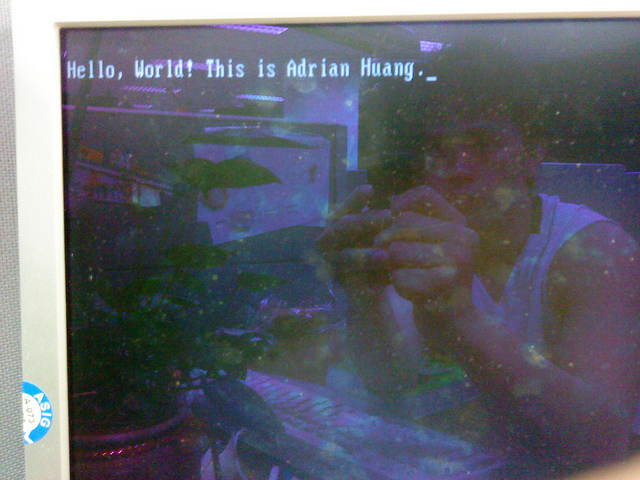以GNU Assembler組合語言撰寫] (一) 開機Hello World實例
小弟最近想嘗試利用GAS(GNU Assembler)組合語言撰寫非常小型的作業系統,本篇文章說明如何利用GAS組合語言在終端機上印出Hello World.
簡介x86 CPU開機流程
x86 CPU開機後,首要之事會先跳至0xFFFF0執行BIOS ROM的程式,當BIOS測試程序通過後,BIOS便會把執行權交給下一個程式 (boot loader或一支小程式),BIOS會將該程式 (通常為一個磁區[Sector]大小,即512 bytes)載入記憶體0x7C00位置,並跳至0x7C00執行該段程式碼。該磁區被稱為MBR,BIOS會檢查該磁區最後兩個位完組必須為0x55AA,否則該磁區該被視為無效的MBR。
所以,首要之事就是利用GAS撰寫一支大小為512位元組的二進位檔 (Binary File),此檔需具備底下功能:
- 檔案系統,如: FAT12, FAT16, FAT32, NTFS等等。
- 利用BIOS中斷號碼0x10將資料寫至螢幕。
- 在最後兩個位元組寫入0x55AA以便通過BIOS識別。
底下為原始碼:
.code16
.section .text
.global main
main:
# FAT12 file system format
jmp start_prog # jmp instruction
.byte 0x90
.ascii "ADRIAN " # OEM name (8 bytes)
.word 512 # Bytes per sector
.byte 1 # Sector per cluster
.word 1 # Reserved sector count: should be 1 for FAT12
.byte 2 # Number of file allocation tables.
.word 224 # Maximum number of root directory entries.
.word 2880 # Total sectors
.byte 0xf0 # Media descriptor:
.word 9 # Sectors per File Allocation Table
.word 18 # Sectors per track
.word 2 # Number of heads
.long 0 # Count of hidden sectors
.long 2880 # Total sectors: 18 (sectors per track) * 2 (heads) * 80 (sectors) = 2880
.byte 0 # Physical driver number
.byte 0 # Reserved
.byte 0x29 # Extended boot signature
.long 0x12345678 # Serial Number
.ascii "HELLO-OS " # Volume Label
.ascii "FAT12 " # FAT file system type
.fill 18, 1, 0 # fill 18 characters with zero
start_prog:
movw $0, %ax # Initialize register
movw %ax, %ss
movw %ax, %ds
movw %ax, %es
movw $msg, %si # move the address of msg to SI
loop:
movb $0xe, %ah
movb (%si), %al # move the first character of msg to AL register
cmpb $0, %al
je fin
int $0x10 # write the specific character to console
addw $1, %si
jmp loop
fin:
# do nothing
msg:
.ascii "Hello, World! This is Adrian Huang."
.byte 0
.org 0x1FE, 0x00 # fill the rest of characters with zero until the 254th character
# Boot sector signature
.byte 0x55
.byte 0xaa
Compile and Link
以"gcc -c"將.S組合語言轉為成object file `
adrian@adrian-desktop:~/working/build_os/my_ex/02day/helloos4$ ls
hello.S
adrian@adrian-desktop:~/working/build_os/my_ex/02day/helloos4$ gcc -c hello.S
adrian@adrian-desktop:~/working/build_os/my_ex/02day/helloos4$ file hello.o
hello.o: ELF 64-bit LSB relocatable, x86-64, version 1 (SYSV), not stripped
adrian@adrian-desktop:~/working/build_os/my_ex/02day/helloos4$
再經由ld連結器將此object轉換成plain binary file
$ ld -Ttext=0x7C00 hello.o -o hello.bin --oformat binary
$ file hello.bin
hello.bin: DOS floppy 1440k, x86 hard disk boot sector
利用xxd工具觀察helo.bin格式 (以十六進制)
adrian@adrian-desktop:~/working/build_os/my_ex/02day/helloos4$ xxd hello.bin
0000000: eb4e 9041 4452 4941 4e20 2000 0201 0100 .N.ADRIAN .....
0000010: 02e0 0040 0bf0 0900 1200 0200 0000 0000 ...@............
0000020: 400b 0000 0000 2978 5634 1248 454c 4c4f @.....)xV4.HELLO
0000030: 2d4f 5320 2020 4641 5431 3220 2020 0000 -OS FAT12 ..
0000040: 0000 0000 0000 0000 0000 0000 0000 0000 ................
0000050: b800 008e d08e d88e c0be 6b7c b40e 8a04 ..........k|....
0000060: 3c00 7407 cd10 83c6 01eb f148 656c 6c6f <.t........Hello
0000070: 2c20 576f 726c 6421 2054 6869 7320 6973 , World! This is
0000080: 2041 6472 6961 6e20 4875 616e 672e 0000 Adrian Huang...
0000090: 0000 0000 0000 0000 0000 0000 0000 0000 ................
00000a0: 0000 0000 0000 0000 0000 0000 0000 0000 ................
00000b0: 0000 0000 0000 0000 0000 0000 0000 0000 ................
00000c0: 0000 0000 0000 0000 0000 0000 0000 0000 ................
00000d0: 0000 0000 0000 0000 0000 0000 0000 0000 ................
00000e0: 0000 0000 0000 0000 0000 0000 0000 0000 ................
00000f0: 0000 0000 00ll
00 0000 0000 0000 0000 0000 ................
0000100: 0000 0000 0000 0000 0000 0000 0000 0000 ................
0000110: 0000 0000 0000 0000 0000 0000 0000 0000 ................
0000120: 0000 0000 0000 0000 0000 0000 0000 0000 ................
0000130: 0000 0000 0000 0000 0000 0000 0000 0000 ................
0000140: 0000 0000 0000 0000 0000 0000 0000 0000 ................
0000150: 0000 0000 0000 0000 0000 0000 0000 0000 ................
0000160: 0000 0000 0000 0000 0000 0000 0000 0000 ................
0000170: 0000 0000 0000 0000 0000 0000 0000 0000 ................
0000180: 0000 0000 0000 0000 0000 0000 0000 0000 ................
0000190: 0000 0000 0000 0000 0000 0000 0000 0000 ................
00001a0: 0000 0000 0000 0000 0000 0000 0000 0000 ................
00001b0: 0000 0000 0000 0000 0000 0000 0000 0000 ................
00001c0: 0000 0000 0000 0000 0000 0000 0000 0000 ................
00001d0: 0000 0000 0000 0000 0000 0000 0000 0000 ................
00001e0: 0000 0000 0000 0000 0000 0000 0000 0000 ................
00001f0: 0000 0000 0000 0000 0000 0000 0000 55aa ..............U.
接著,使用qemu驗證hello.bin
qemu-system-i386 -hda hello.bin

為了讓此範例更真實,筆者有一臺機器備有CF Card,將hello.bin透過dd工具寫進此CF Card最前面的512 bytes, 命令如下:
adrian@adrian-mem1:~/img$ sudo dd if=./hello.bin of=/dev/sda
[sudo] password for adrian:
1+0 records in
1+0 records out
512 bytes (512 B) copied, 0.00124243 s, 412 kB/s
adrian@adrian-mem1:~/img$
將該系統重開並選擇CF Card開機,其畫面如下:

【Reference】 1.30天打造OS!作業系統自作入門
- Jserv's Blog
- X86 開機流程小記
- Linux assemblers: A comparison of GAS and NASM